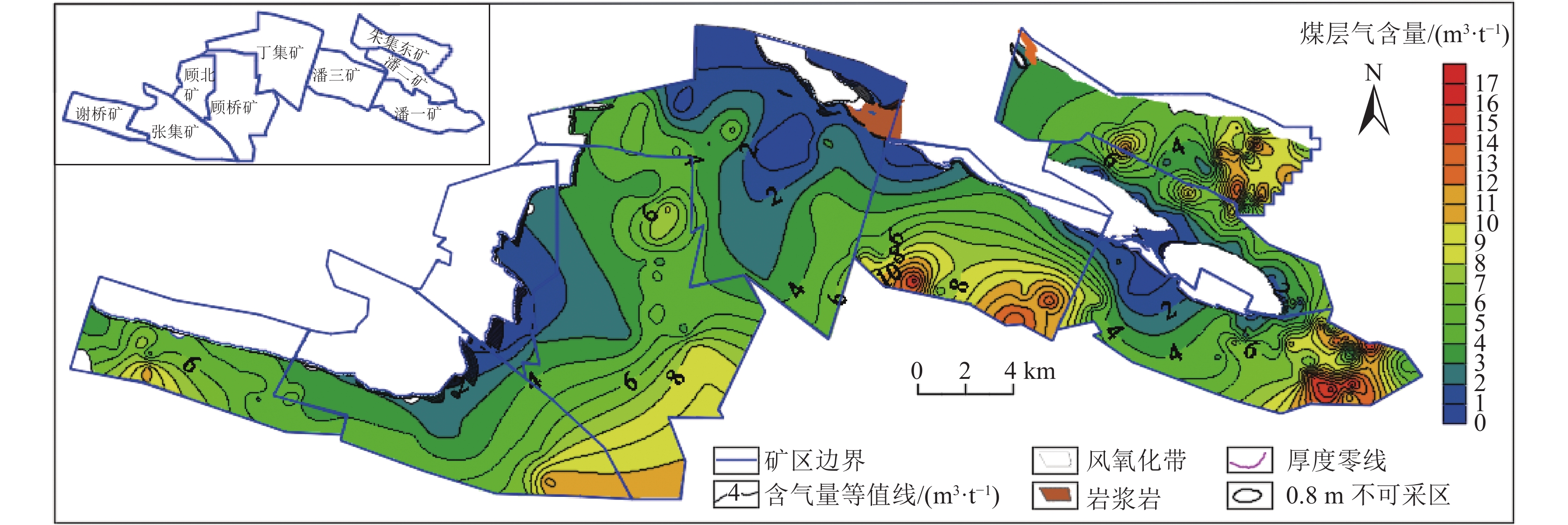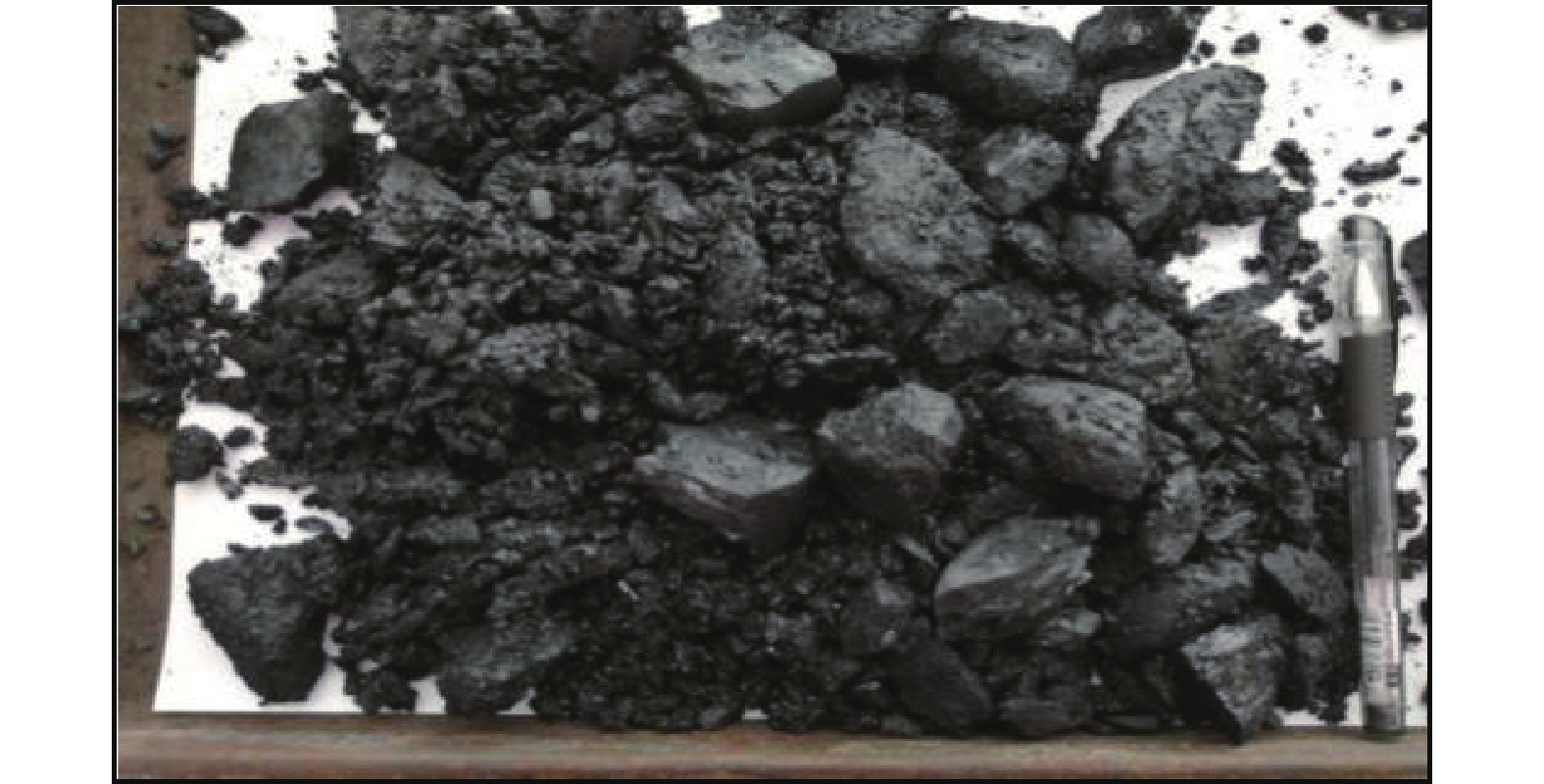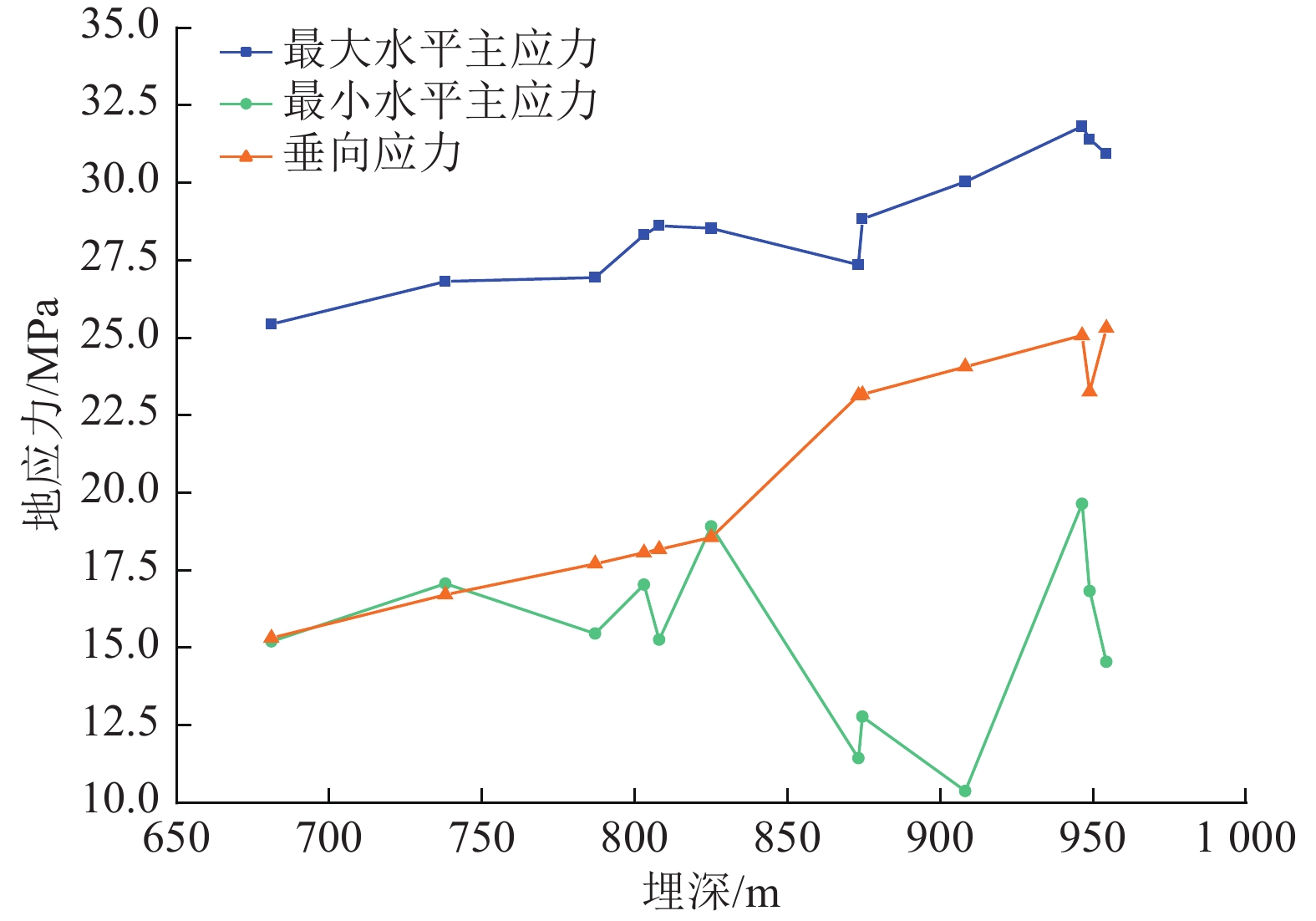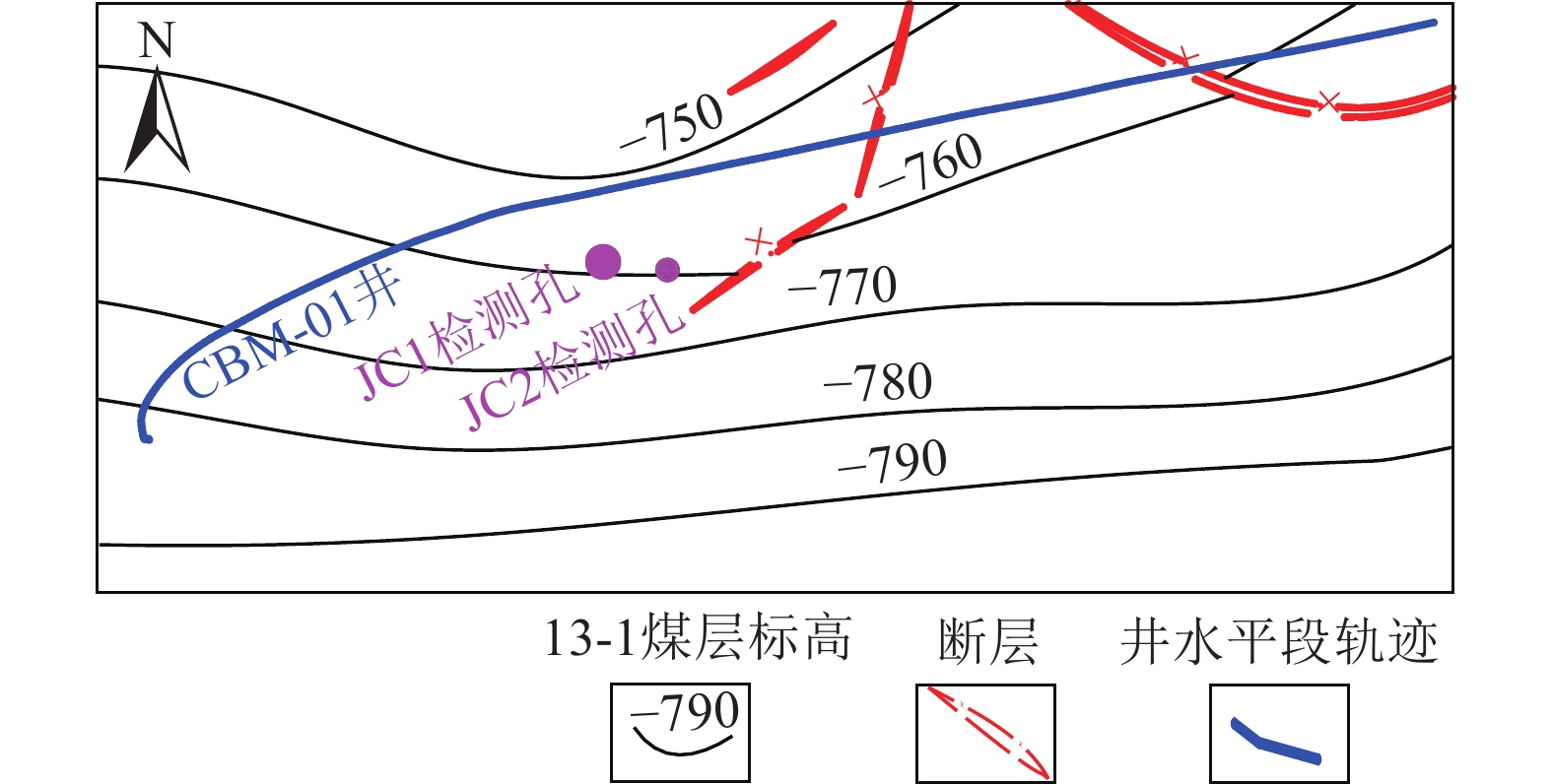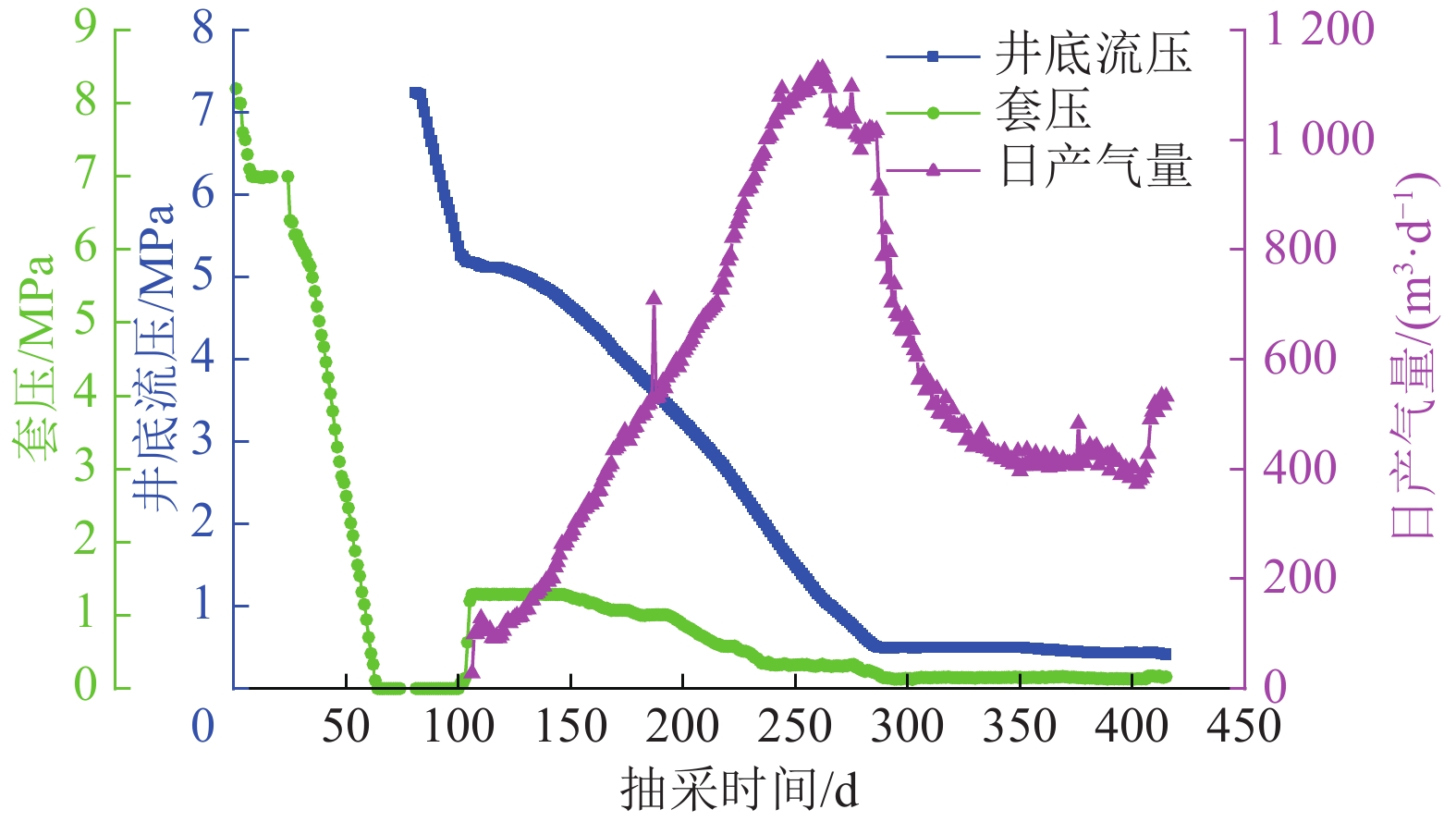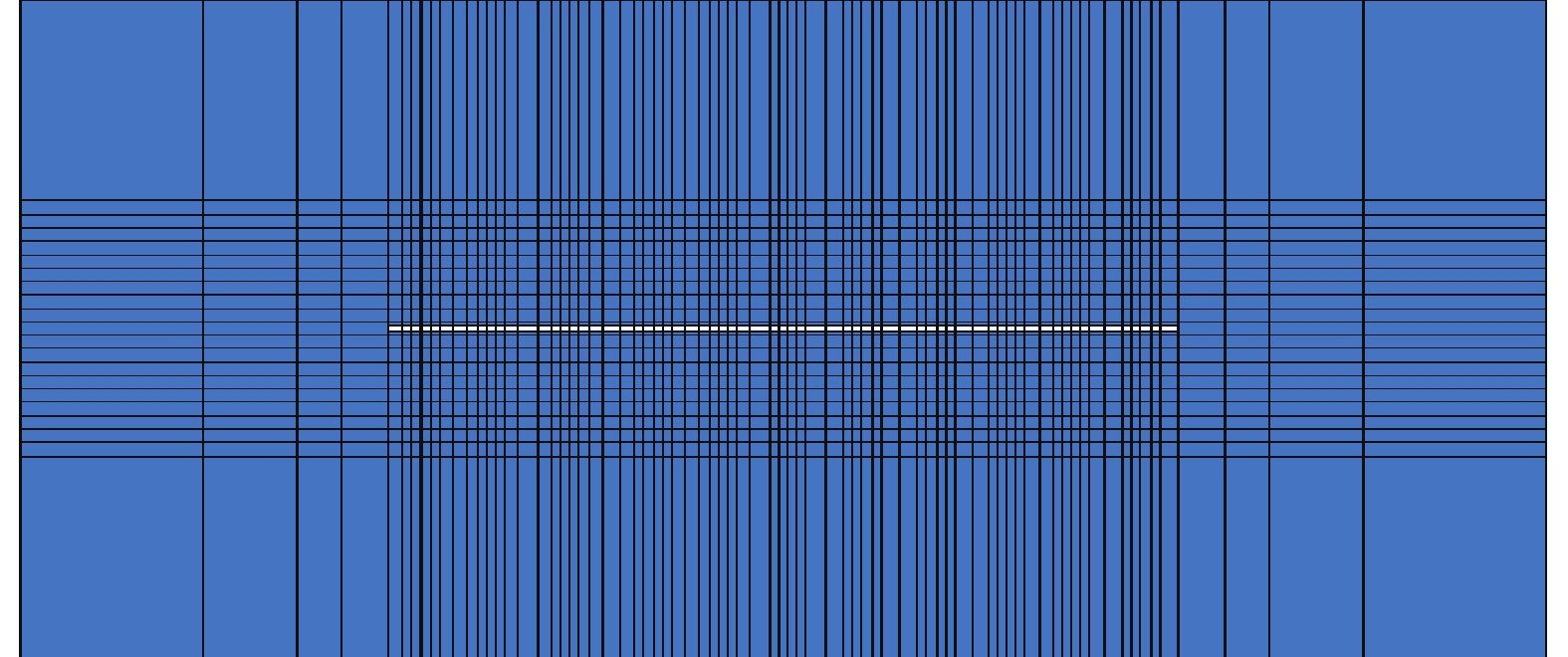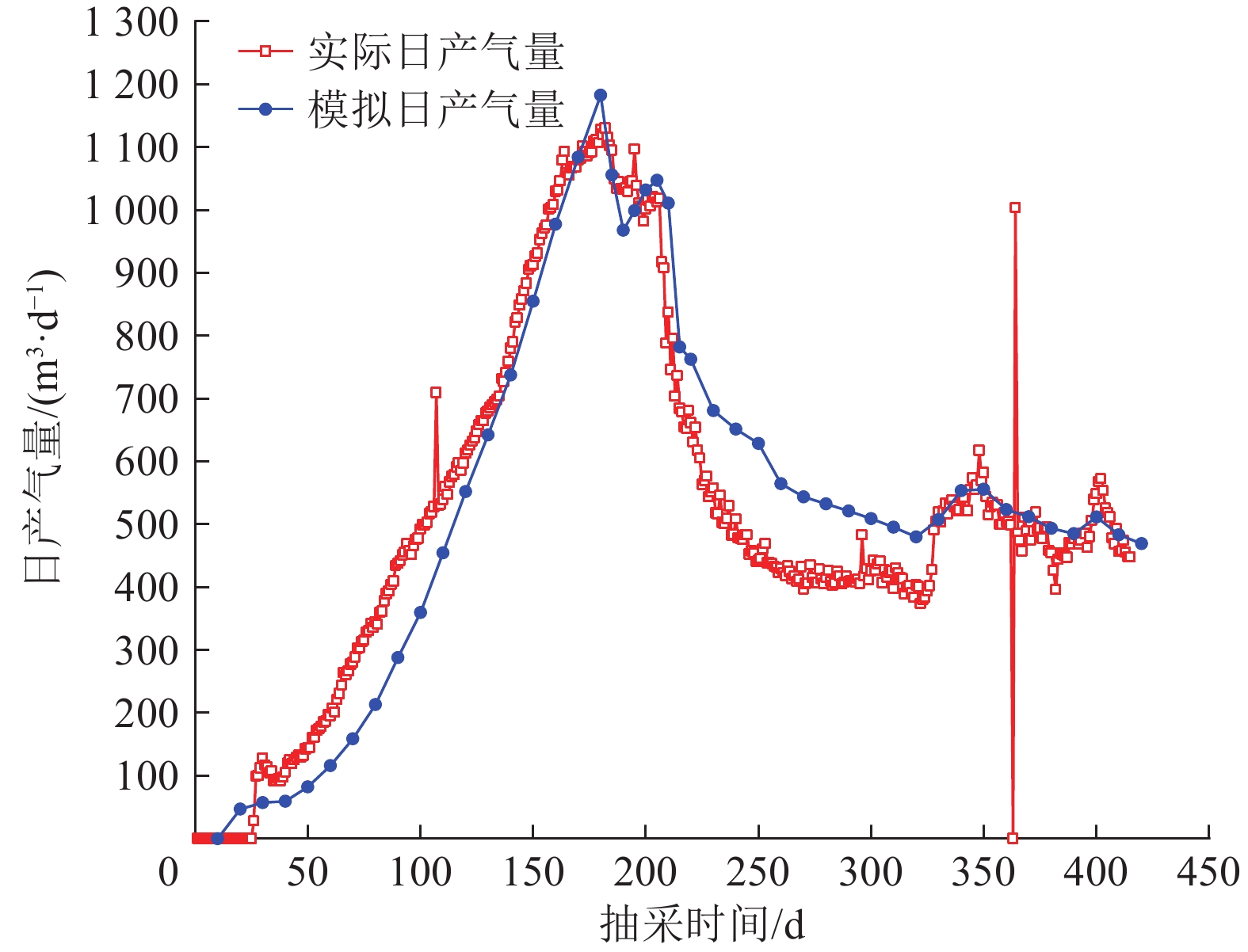Study on technology and effect of gas extraction in horizontal well with segmental hydraulic fracture in roof of coal seam in Huainan mining area
-
摘要:
淮南矿区为典型高瓦斯矿区,煤层碎软、渗透率低、瓦斯含量偏高、抽采难度大,为探讨地面煤层气顶板分段压裂水平井在矿区的技术可行性与瓦斯治理效果,在分析矿区主要煤层13-1煤储层特征基础上,采用应力解除法进行了煤层三向地应力测试,结果显示三向应力场类型主要为σh,max >σv >σh,min,具有实施顶板分段压裂水平井技术的充分条件;利用MFrac Suite软件分别模拟了水平段距离煤层1、3、5 m时的压裂缝参数,压裂缝半长最大107.33 m、最小89.47 m,具有理想的压裂效果,说明顶板分段压裂水平井在淮南矿区具有比较好的地质适应性与可行性。以潘一煤矿13-1煤层“L”型顶板分段压裂水平井CBM01井为研究对象,采用井下钻孔检测与数值模拟等手段综合分析了瓦斯治理效果,结果显示CBM01井抽采415 d即显著降低了煤层瓦斯压力与瓦斯含量,距离水平井50、65 m处瓦斯压力由6.4 MPa分别降至2.6、2.7 MPa,降低幅度均超过55 %,水平段两侧各15~20 m范围内瓦斯含量由13.5 m3/t降至最大9.11 m3/t、最小6.92 m3/t,平均7.92 m3/t,约10 m范围均降至8 m3/t以下。最后,采用数值模拟方法预测了CBM01井抽采10 a的产气效果及瓦斯治理效果,气井抽采10 a累计产气约272.08×104 m3,水平段倾向单侧约150 m范围内气含量均降至8 m3/t以下、压力均降至3 MPa以下。综合研究结果表明,煤层顶板分段压裂水平井技术在淮南矿区瓦斯治理方面均具有较大的优势和应用效果。
Abstract:Huainan mining area is a typical high-gas area, with broken soft coal seam, low permeability, high gas content, and difficulty in extraction. In order to probe into the technical feasibility and gas control effect of the horizontal well for segmental hydraulic fracture in roof of coal seam in mining area, a three-dimensional in-situ stress test of coal seam was carried out using the stress relief method based on the analysis of the characteristics of the 13-1 coal reservoir, which was the main coal seam in the mining area. The results shown that, the three-dimensional stress field was mainlyσh,max >σv >σh,min, which had sufficient conditions for the implementation of horizontal well with segmental hydraulic fracture in roof of coal seam. MFrac Suite software was used to simulate the fracture parameters of horizontal section at 1, 3 and 5 m from the coal seam. The maximum half-length of the fracture was 107.33 m and the minimum was 89.47 m, which was ideal for fracturing, indicating that the horizontal well with segmental hydraulic fracture had better geological adaptability and feasibility in Huainan mining area. Taking the CBM01 well, a horizontal well with L-type roof segmental fracturing in the 13-1 coal seam of Panyi coal mine, as the research object, the effect of gas control and management was comprehensively analyzed by means of borehole detection and numerical simulation. The results shown that, CBM01 well significantly reduced the gas pressure and gas content of coal seam after 415 d of extraction. The gas pressure at 50 and 65 m from the horizontal well decreased from 6.4 MPa to 2.6 and 2.7 MPa, respectively, by more than 55%. The gas content decreased from 13.5 m3/t to a maximum of 9.11 m3/t, a minimum of 6.92 m3/t, an average of 7.92 m3/t in an area of about 15-20 m on each side of the horizontal section, and decreased to less than 8 m3/t within about 10 m. Finally, a numerical simulation method was used to predict the gas production effect of CBM 01 well extracting for 10 a and the effect with gas control. The cumulative gas production of gas well was about 272.08×104 m3 in 10 a, and the gas content in the range of about 150 m on one side of the horizontal section was reduced to less than 8 m3/t, and the pressure was reduced to less than 3 MPa. Comprehensive research results shown that the horizontal well technology of segmental hydraulic fracturing in roof of coal seam had greater advantage and application effect in gas control and management in Huainan mining area.
-
0. 引 言
据预测,我国煤层气地质资源量达 36.81 万亿m3,其中煤矿区煤层气资源量超过16万亿m3,占全国煤层气总资源量的43.5%[1-4]。对于煤矿区来说,通过地面井开发能有效扼制瓦斯灾害事故、提高煤炭安全生产效率、清洁利用煤层气资源 [5-7],有助于持续巩固煤炭资源在我国能源结构中“稳定器”和“压舱石”的作用 [8-9]。我国煤矿区地面煤层气勘探开发始于20世纪80年代,历经40多年已取得了卓越成绩,也为全国煤层气产气量提升做出了巨大贡献。近年来,我国碎软低渗煤层煤矿区地面煤层气开发也获得了多项技术突破,煤层顶板水平井分段压裂技术取得了单井最高日产气量突破1万m3的记录[10],煤矿采动区地面L型水平井技术单井日产甲烷纯量超过3万m3[11],这极大鼓舞了碎软低渗煤层矿区加大地面煤层气抽采力度的热情和信心,很多矿区如淮北矿区、淮南矿区、晋城矿区、平顶山矿区等先后进行了规模不等的地面水平井工程实践[12-17]。
淮南矿区是我国典型的碎软低渗煤层发育区,煤层松软、低渗特征显著,煤层气含量高,据预测2 000 m以浅煤层气资源为4 900.38亿m3[18],资源规模大、瓦斯灾害问题突出。近年来,淮南矿区主要采取井下抽采为主、地面抽采为辅的瓦斯抽采方式[19-23],虽取得了一定的效果,但由于井下抽采方式受矿井建设、井下掘进和采煤工程影响比较严重,矿区仍存在掘采抽矛盾问题,煤层气资源也没有得到有效抽采利用。
2018年至今,淮南矿区借鉴淮北矿区煤层气地面抽采成功经验,开展了煤层顶板水平井的示范工程,取得了比较宝贵的经验。本文在对淮南矿区煤层气地质与储层条件研究基础上,采用三向地应力测试与压裂数值模拟技术,系统研究了顶板分段压裂井技术在矿区的地质适应性与技术可行性,并采用井下钻孔检测方法与抽采数值模拟相结合方法,对技术应用情况与瓦斯治理效果进行综合评价,以期为矿区规模化实施顶板水平井分段压裂技术提供借鉴作用。
1. 顶板分段压裂水平井技术特点及地质适应性
1.1 顶板分段压裂水平井技术特点
煤层气顶板分段压裂水平井技术原理及内涵主要为:基于顶板岩层相对煤层具有脆性高、裂缝扩展压力大的特点,在顶板三向地应力中垂向应力不为最小值情况下,通过在顶板直接水力压裂产生压裂缝,压裂缝一方面在顶板岩层水平方向上快速扩展延伸,另一方面也向下扩展穿入碎软煤层,对煤层压裂产生牵引作用形成较长的压裂缝,从而达到理想的储层改造效果[10]。其技术要点包括:将“U”型或“L”型水平井水平段布置在距离煤层2 m左右的顶板岩层中,并在水平段下套管固井;采用泵送桥塞+向下定向射孔联作分段压裂工艺,实施大液量、大排量、中砂比的高强度压裂作业,最后在对接垂直井或“L”型井进行排水产气(图1)[10]。
1.2 淮南矿区煤层气地质条件
淮南矿区地处安徽省淮北平原南部,地质构造复杂,区域断裂以东西向和北北东向2组断裂为主,北西向断裂次之,断层主要有杨村集—朱集断层、潘集北部断层等(图2)。矿区含煤地层为二叠系山西组、下石盒子组、上石盒子组,可采煤层主要有13-1煤、11-2煤、8煤、4-1煤、3煤和1煤,其中上石盒子组13-1煤层为主要开采煤层。
13-1煤层厚度基本都在2 m以上,矿区由北向南厚度逐渐增大,在潘一矿、顾桥矿南部厚度都超过了5 m(图3)。煤层气含量一般高于6 m3/t,矿区南部气含量高于北部,基本都在8 m3/t以上;东部气含量普遍高于西部,潘一矿、潘三矿、朱集东矿气含量一般都在10 m3/t以上(图4)。可以看出,潘一矿、潘三矿等是煤层气富集区。
受多期构造运动演化影响,淮南矿区13-1煤层煤体整体比较破碎(图5),煤体结构以碎粒、糜棱、碎裂类型为主,所测储层渗透率基本小于0.1×10−15 m2,采用煤层中常规水力压裂改造措施难以产生理想的产气效果。
1.3 地质适应性及可行性
淮南矿区13-1煤层埋深262.26~
1065.55 m、平均694.06 m,煤层顶板以砂质泥岩、泥岩、细砂岩、粉砂岩为主,抗压强度在26~40 MPa、泊松比在0.21~0.26,水力压裂施工具有比较好的岩石力学条件。矿区主体构造受郯庐断裂影响,主地应力方向以近NEE向为主。矿区采用应力解除法、滞弹性应变恢复法开展了三向地应力测试,水平主应力占主导优势地位,应力场类型主要为σh,max > σv > σh,min(图6),按照顶板分段压裂水平井技术原理可知:从13-1煤层顶板向下部煤层进行射孔、压裂,压裂缝容易压穿煤岩界面,并在煤层中扩展延伸。采用模拟软件MFrac Suite模拟了13-1煤层顶板分段压裂水平井不同情况下的压裂缝效果(表1),模拟结果显示,水平段距离煤层分别为1、3、5 m时,压裂缝半长分别为107.33、105.47、89.47 m,呈逐渐减小趋势;压裂总缝高分别为21.06、23.62、33.88 m,呈逐渐增大趋势;平均压裂缝宽分别为0.30、0.27、0.31 m,结果基本相同。模拟结果一方面表明顶板分段压裂水平井在淮南矿区具有比较好的地质适应性与技术可行性,另一方面也说明水平段距离煤层越近、越能产生长压裂缝,但考虑到实际钻井施工中水平轨迹控制技术存在多种不确定性问题,水平段应布置在距离煤层3 m左右。
表 1 淮南矿区顶板分段压裂水平井压裂缝模拟结果Table 1. Fracture simulation results of horizontal well with sublevel roof fracturing in Huainan Mining Aream 水平段与煤层距离 压裂半缝长 压裂总缝高 平均压裂缝宽 1.0 107.33 21.06 0.30 3.0 105.47 23.62 0.27 5.0 89.47 33.88 0.31 2. 顶板分段压裂水平井工程及产气特征
本次研究对象为淮南矿区潘一井田L型煤层顶板分段压裂水平井,井号CBM01井,抽采目的层为13-1煤,水平段延伸方向为NEE向,水平段全长857 m(图7),钻遇煤层厚度平均为2.2 m,水平段轨迹控制在距13-1煤顶1.3~4.9 m。
CBM01井采用三开井身结构,一开采用直径444.5 mm 钻头、直径346 mm 表层套管,固井水泥浆返至地面;二开采用直径311 mm钻头、直径244.5 mm 技术套管;三开采用采用直径215.9 mmPDC 钻头、直径139.7 mm生产套管。水平段分11段进行压裂,压裂段长67~107 m。各段施工平均砂比6.02%~9.38 %,平均排量9.0~9.4 m3/min,施工破裂压力在20.0~28.4 MPa;共注入压裂液14 724.4 m3,加入石英砂640.8 m3,现场压裂缝监测结果显示压裂缝半长在15.6~64 m。排采设备采用GLB300螺杆泵,排采初始平均降压速度0.115 MPa/d,临近解吸阶段排采速度0.10 MPa/d左右;排采78 d井口开始出现套压约0.07 MPa、井底流压约5.27 MPa,排采83 d后套管见气,日产气量为28.26 m3/d;排采至415 d,最大日产气量
1130.12 m3/d,平均日产气量为558.52 m3/d,累计产气量17.31×104 m3(图8)。3. 瓦斯治理效果评价方法及结果分析
煤层气及瓦斯抽采效果评价主要有检测法和数值模拟法,其中检测法需要施工地面钻孔或井下钻孔测试煤储层参数,准确性高,但受投入成本限制,一般只能获取局部范围的数据;数值模拟法则主要依托于各类模拟软件,能获取点、面情况下各类参数在各个时间段的变化数据,但其准确性低,需结合实际检测数据进行二次校正[24-27]。采用检测法和数值模拟法相结合,综合分析了CBM01井瓦斯治理效果。
3.1 井下钻孔检测结果
CBM01井抽采至415 d时,共在井下距离该井水平段约50、65 m位置分别实施了2个检测钻孔JC1、JC2,位置如图7所示。2个检测钻孔主要进行了13-1煤层瓦斯压力测试,结果分别为2.6、2.7 MPa,相比井田之前原始瓦斯压力6.4 MPa分别降低了3.8、3.7 MPa,降幅分别为59.4%、57.8%(表2),可见CBM01井短时间抽采即显著降低了煤层气储层压力。
表 2 井下检测钻孔瓦斯压力测试结果Table 2. Results of gas pressure test in borehole钻孔 与地面压裂井距离/ m 瓦斯压力/ MPa JC1 50 2.6 JC2 65 2.7 3.2 数值模拟结果分析
采用煤层气CBM-SIM软件对CBM01井抽采效果进行模拟,该软件充分考虑了煤储层的特点,依据描述煤层气吸附−解吸过程的Langmuir方程、气体扩散过程的Fick第一定律方程、气体流动过程的Darcy定律等主要控制方程,结合该区域煤层气含量、吸附参数、渗透率进行模拟计算。根据CBM01水平井钻井、压裂工程资料,构建了水平井水平段网格模拟模型,平面共划分网格数87个(图9)。依据抽采区煤层气参数井气含量测试、注入/压降试井资料,获取煤层、煤储层、含气性等相关参数,对各网格参数进行赋值,构建水平井地质模型,所应用的主要地质参数见表3。
表 3 CBM01井抽采模拟所用地质参数Table 3. Geological parameters used in simulation of extraction of well CBM01抽采煤层 煤厚/ m 埋深/ m 气含量/ (m3·t−1) Langmuir体积 / (m3·t−1) Langmuir/ MPa 渗透率/(10−15 m2) 孔隙率/ % 密度/ (t·m−3) 储层压力/ MPa 13-1煤 2.2 782 13.5 17.49 0.84 0.11 2 1.42 7.82 根据CBM01水平井排采工程总结及截止排采415 d排采数据,制定了精细化排采管理制度(每10 d1个工作制度)。首先,利用CBM-SIM模拟软件对该井日产气量进行预测,根据预测日产气量与实际日产气量的拟合数据和曲线形态对比结果,按照测试技术的准确性程度高低顺序,采用常规试凑法对准确性低的部分参数进行调整,直至拟合日产气量和实际日产气量结果比较吻合(图10)。主要对13-1煤Langmuir吸附压力和原始渗透率进行了调整(表4),压裂工程参数主要调整各压裂段压裂缝长度,调整后裂缝半长平均约20 m。
表 4 CBM01井模拟修正后地质参数Table 4. Modified geological parameters of CBM01 well simulation煤层 煤厚/ m 埋深/ m 气含量/ (m3·t−1) Langmuir体积/ (m3·t−1) Langmuir/ MPa 渗透率/10−15 m2 孔隙率/ % 密度/ (t·m−3) 储层压力/ MPa 13-1煤 2.2 782 13.5 17.49 1.90 0.02 2 1.42 7.82 采用历史拟合修正后地质参数对CBM01井进行抽采模拟,获取抽采至415 d时13-1煤剩余储层压力与气含量分布特征。首先,依据井下2个检测钻孔瓦斯压力测试结果,结合矿井储层压力与瓦斯压力校正系数,对抽采至415 d后检测钻孔相应位置储层压力进行校正;其后,依据抽采后压力分布规律对抽采影响范围内其他区域压力进行调整;最后,结合Langmuir吸附体积和吸附压力结果,依据Langmuir吸附模型对全范围煤层气含量进行调整,获取抽采至415 d时抽采范围内煤层剩余气含量变化规律。
分析结果表明,抽采至415 d时,CBM01水平井倾向两侧50~65 m范围,最大储层压力3.90 MPa、平均约3.23 MPa(图12),瓦斯压力最大3.12 MPa、平均约2.66 MPa,瓦斯压力模拟结果基本与2个检测钻孔测试结果吻合。据此,对CBM01水平井倾向两侧15~20 m范围气含量进行了模拟,抽采至415 d时13-1煤层剩余气含量最大9.11 m3/t、最小6.92 m3/t,平均约7.92 m3/t,最小降低幅度达32%,水平段两侧各10 m范围内降至8 m3/t以下(图11),可以看出,短时间抽采下煤层气含量的降低幅度整体小于储层压力,但水平井两侧<20 m范围的煤层气含量有大幅度的降低。
本次也对CBM01井抽采10 a后的产气及瓦斯治理结果进行了预测。预测结果显示, CBM01井抽采10 a后,日产气量平均824.48 m3/d、累计产气量约272.08×104 m3(图12),水平段射孔位置倾向单侧100 m范围采收率平均达69 %;水平段倾向两侧各约150 m范围内,13-1煤剩余气含量都有所变化,射孔位置方向均降至8m3/t以下,最低降至2.05 m3/t;倾向两侧各约150 m范围内13-1煤储层压力降至3 MPa以下,两侧各约100 m范围内储层压力降至2 MPa以下,射孔位置方向均降至0.74 MPa以下(图13),达到了煤矿安全生产条件。
由CBM01井钻完井与压裂缝监测结果显示,钻遇13-1煤层厚度仅2.2 m,抽采范围与煤层气量都相对小,抽采后期气源不足,导致产气效果较差;但由抽采后13-1煤层剩余气含量与压力分析结果发现,CBM01井在短时间内快速降低了煤层气含量与瓦斯压力,表明煤层顶板分段压裂水平井技术在淮南矿区瓦斯治理方面具有比较大的优势,有助于缓解煤矿煤炭开采中的掘−采−抽矛盾、提高煤炭生产效率,今后采用该技术进行煤矿瓦斯治理同时,应进一步开展井位部署、压裂与排采工艺等研究工作,以提高产气效果,实现煤层气资源高效回收与瓦斯灾害治理的双重效益。
4. 结 论
1)分析了淮南矿区13-1煤层煤层气地质条件,采用应力解除法测试了煤层三向地应力、压裂数值模拟方法模拟了不同条件下压裂效果,认为顶板分段压裂水平井技术在淮南矿区具有比较好的地质适应性及技术可行性。
2)分析了淮南矿区13-1煤层L型顶板分段压裂水平井CBM01井应用情况,抽采415 d最大日产气量
1130.12 m3/d、累计产气量17.31×104 m3;采用井下钻孔检测与数值模拟相结合方法研究了CBM01井的瓦斯治理效果,抽采至415 d即能显著降低水平井两侧的压力,对两侧各<20 m范围的煤层气含量也有大幅度降低作用。3)采用数值模拟方法预测了CBM01井抽采10 a的产气效果与瓦斯治理效果,日产气量平均824.48 m3/d、累计产气272.08×104 m3,水平段射孔方向两侧100 m范围采收率平均达69%;水平段两侧约150 m范围13-1煤层剩余气含量均降至8 m3/t以下、压力降至3 MPa以下。
4)煤层顶板分段压裂水平井技术在淮南矿区瓦斯治理方面具有比较理想的效果,今后可在井位部署、压裂工艺、排采制度等方面开展进一步的优化工作,实现煤层气资源高效回收与瓦斯治理的双重效益。
-
表 1 淮南矿区顶板分段压裂水平井压裂缝模拟结果
Table 1 Fracture simulation results of horizontal well with sublevel roof fracturing in Huainan Mining Area
m 水平段与煤层距离 压裂半缝长 压裂总缝高 平均压裂缝宽 1.0 107.33 21.06 0.30 3.0 105.47 23.62 0.27 5.0 89.47 33.88 0.31 表 2 井下检测钻孔瓦斯压力测试结果
Table 2 Results of gas pressure test in borehole
钻孔 与地面压裂井距离/ m 瓦斯压力/ MPa JC1 50 2.6 JC2 65 2.7 表 3 CBM01井抽采模拟所用地质参数
Table 3 Geological parameters used in simulation of extraction of well CBM01
抽采煤层 煤厚/ m 埋深/ m 气含量/ (m3·t−1) Langmuir体积 / (m3·t−1) Langmuir/ MPa 渗透率/(10−15 m2) 孔隙率/ % 密度/ (t·m−3) 储层压力/ MPa 13-1煤 2.2 782 13.5 17.49 0.84 0.11 2 1.42 7.82 表 4 CBM01井模拟修正后地质参数
Table 4 Modified geological parameters of CBM01 well simulation
煤层 煤厚/ m 埋深/ m 气含量/ (m3·t−1) Langmuir体积/ (m3·t−1) Langmuir/ MPa 渗透率/10−15 m2 孔隙率/ % 密度/ (t·m−3) 储层压力/ MPa 13-1煤 2.2 782 13.5 17.49 1.90 0.02 2 1.42 7.82 -
[1] 矿区煤层气开发项目组. 煤层气与煤炭协调开发理论与技术[M]. 北京:科学出版社,2021. [2] 刘大锰,贾奇锋,蔡益栋. 中国煤层气储层地质与表征技术研究进展[J]. 煤炭科学技术,2022,50(1):196−203. LIU Dameng,JIA Qifeng,CAI Yidong. Research progress on coalbed methane reservoir geology and characterization technology in China[J]. Coal Science and Technology,2022,50(1):196−203.
[3] 国土资源部油气资源战略研究中心. 全国煤层气资源评价[M]. 徐州:中国矿业大学出版社,2009. [4] 孙海涛,舒龙勇,姜在炳,等. 煤矿区煤层气与煤炭协调开发机制模式及发展趋势[J]. 煤炭科学技术,2022,50(12):1−13. SUN Haitao,SHU Longyong,JIANG Zaibing,et al. Progress and trend of key technologies of CBM development and utilization in China coal mine areas[J]. Coal Science and Technology,2022,50(12):1−13.
[5] 张 群. 关于我国煤矿区煤层气开发的战略性思考[J]. 中国煤层气,2007,4(4):3−5,15. ZHANG Qun. Strategic thinking on coal mine methane development in China[J]. China Coalbed Methane,2007,4(4):3−5,15.
[6] 刘见中,孙海涛,雷 毅,等. 煤矿区煤层气开发利用新技术现状及发展趋势[J]. 煤炭学报,2020,45(1):258−267. LIU Jianzhong,SUN Haitao,LEI Yi,et al. Current situation and development trend of coalbed methane development and utilization technology in coal mine area[J]. Journal of China Coal Society,2020,45(1):258−267.
[7] 张 群,降文萍,姜在炳,等. 我国煤矿区煤层气地面开发现状及技术研究进展[J]. 煤田地质与勘探,2023,51(1):139−158. ZHANG Qun,JIANG Wenping,JIANG Zaibing,et al. Present situation and technical research progress of coalbed methane surface development in coal mining areas of China[J]. Coal Geology & Exploration,2023,51(1):139−158.
[8] 王国法,任世华,庞义辉,等. 煤炭工业“十三五”发展成效与“双碳”目标实施路径[J]. 煤炭科学技术,2021,49(9):1−8. WANG Guofa,REN Shihua,PANG Yihui,et al. Development achievements of China’s coal industry during the 13th Five Year Plan period and implementation path of“dual carbon” target[J]. Coal Science and Technology,2021,49(9):1−8.
[9] 刘 峰. 双碳背景下煤炭安全区间与绿色低碳技术路径[J]. 煤炭学报,2022,47(1):1−15. LIU Feng. Research on coal safety range and green low−carbon technology path under the dual−carbon background[J]. Journal of China Coal Society,2022,47(1):1−15.
[10] 张 群,葛春贵,李 伟,等. 碎软低渗煤层顶板水平井分段压裂煤层气高效抽采模式[J]. 煤炭学报,2018,43(1):150−159. ZHANG Qun,GE Chungui,LI Wei,et al. A new model and application of coalbed methane high efficiency production from broken soft and low permeable coal seam by roof strata-in horizontal well and staged hydraulic fracture[J]. Journal of China Coal Society,2018,43(1):150−159.
[11] 李国富,张遂安,季长江,等. 煤矿区煤层气“四区联动”井上下联合抽采模式与技术体系[J]. 煤炭科学技术,2022,50(12):14−25. LI Guofu,ZHANG Suian,JI Changjiang,et al. Mechanism and technical system of ground and underground combined drainage of CBM in “four region linkage” in coal mining area[J]. Coal Science and Technology,2022,50(12):14−25.
[12] 巫修平. 碎软低渗煤层顶板水平井分段压裂裂缝扩展规律及机制研究[D]. 北京:煤炭科学研究总院,2017:135−136. WU Xiuping. Research on control mechanism of fracture propagation of multi–stage hydraulic fracturing horizontal well in roof of broken soft and low permeable coal seam[D]. Beijing:China Coal Research Institute,2017:135−136.
[13] 李彬刚. 芦岭煤矿碎软低渗煤层高效抽采技术[J]. 煤田地质与勘探,2017,45(4):81−84. LI Bingang. Technology of CBM extraction in the crushed and soft coal seam in Luling coal mine[J]. Coal Geology & Exploration,2017,45(4):81−84.
[14] 周加佳. 水平井分段压裂技术在煤层气开发中的应用实践[J]. 中国煤炭地质,2019,31(8):27−30. ZHOU Jiajia. Application practice of horizontal well segmental fracturing technology in CBM exploitation[J]. Coal Geology of China,2019,31(8):27−30.
[15] 方良才,李贵红,李丹丹,等. 淮北芦岭煤矿煤层顶板水平井煤层气抽采效果分析[J]. 煤田地质与勘探,2020,48(6):155−160. FANG Liangcai,LI Guihong,LI Dandan,et al. Analysis on the CBM extraction effect of the horizontal wells in the coal seeam roof in Luling coal mine in Huaibei[J]. Coal Geology & Exploration,2020,48(6):155−160.
[16] 孔祥喜,唐永志,李 平,等. 淮南矿区松软低透煤层煤层气开发利用技术与思考[J]. 煤炭科学技术,2022,50(12):26−35. KONG Xiangxi,TANG Yongzhi,LI Ping,et al. Thingking and utilization technology of coalbed methane in soft and low permeability coal seams in Huainan Mining Area[J]. Coal Science and Technology,2022,50(12):26−35.
[17] 李延河. 地面井分区式瓦斯抽采技术体系及工程实践[J]. 煤炭科学技术,2023,51(3):100−108. LI Yanhe. Surface well partition gas extraction technology system and engineering practice[J]. Coal Science and Technology,2023,51(3):100−108.
[18] 赵 干,廖斌琛. 淮南矿区煤层气开发利用现状及展望[J]. 中国煤层气,2007,4(4):12−15. ZHAO Gan,LIAO Binchen. Current status and prospect of CMM development and utilization in Huainan Coal Mining Area[J]. China Coalbed Methane,2007,4(4):12−15.
[19] 袁 亮. 松软低透煤层群煤层气抽采理论与技术[M]. 北京:煤炭工业出版社,2004. [20] 梁云培. 淮南矿区地面钻井瓦斯抽采技术实践[J]. 采矿与安全工程学报,2007,24(4):409−413. LIANG Yunpei. Practice of methane drainage by surface well drilling in Huainan Mining Area[J]. Journal of Mining & Safety Engineering,2007,24(4):409−413.
[21] 袁 亮. 卸压开采抽采瓦斯理论及煤与瓦斯共采技术体系[J]. 煤炭学报,2009,34(1):5−12. YUAN Liang. Theory of pressure−relieved gas extraction and technique system of integrated coal production and gas extraction[J]. Journal of China Coal Society,2009,34(1):5−12.
[22] 袁 亮,郭 华,李 平,等. 大直径地面钻井采空区采动区瓦斯抽采理论与技术[J]. 煤炭学报,2013,38(1):1−8. YUAN Liang,GUO Hua,LI Ping,et al. Theory and technology of goaf gas drainage with large−diameter surface boreholes[J]. Journal of China Coal Society,2013,38(1):1−8.
[23] 夏仕方. 采动区地面钻井技术在淮南矿区煤层气抽采中的应用[J]. 建井技术,2020,41(2):48−52. XIA Shifang. Surface drilling technology in mining area applied to coalbed methane drainage in Huainan mining area[J]. Mine Construction Technology,2020,41(2):48−52.
[24] 李国富,李贵红,刘 刚. 晋城矿区典型区煤层气地面抽采效果分析[J]. 煤炭学报,2014,39(9):1932−1937. LI Guofu,LI Guihong,LIU Gang. Analysis on the ground extraction effect of coal−bed methane at typical area in Jincheng, China[J]. Journal of China Coal Society,2014,39(9):1932−1937.
[25] 张 群. 国外煤层气储层数值模拟技术的现状及发展趋势[J]. 煤田地质与勘探,2004,32(S):18−24. ZHAGN Qun. Present situation and development trend of CBM reservoir numerical simulation in foreign countries[J]. Coal Geology & Exploration,2004,32(S):18−24.
[26] 赵继展. 煤矿采动区煤层气井产能数值模拟及应用研究[D]. 北京:煤炭科学研究总院,2018:48−62. ZHAO Jizhan. Study on numerical simulation and application of gob coal seam gas well productivity in longwall working face [D]. Beijing: China Coal Research Institute, 2018:48−62.
[27] 降文萍,张 群,姜在炳,等. 基于产气量模拟的采动影响下煤层渗透性变化规律[J]. 煤矿安全,2016,47(1):19−22. JIANG Wenping,ZHANG Qun,JIANG Zaibing, et al. Research on the permeability change of coal seam under the mining influence based on the gas production simulation[J]. Safety in Coal Mines,2016,47(11):19−22.
-
期刊类型引用(1)
1. 汪有清,吴明,万业婷. 新集二矿1煤组坚硬覆岩裂隙瓦斯异常涌出成因机制研究. 当代化工研究. 2024(22): 153-155 .  百度学术
百度学术
其他类型引用(0)



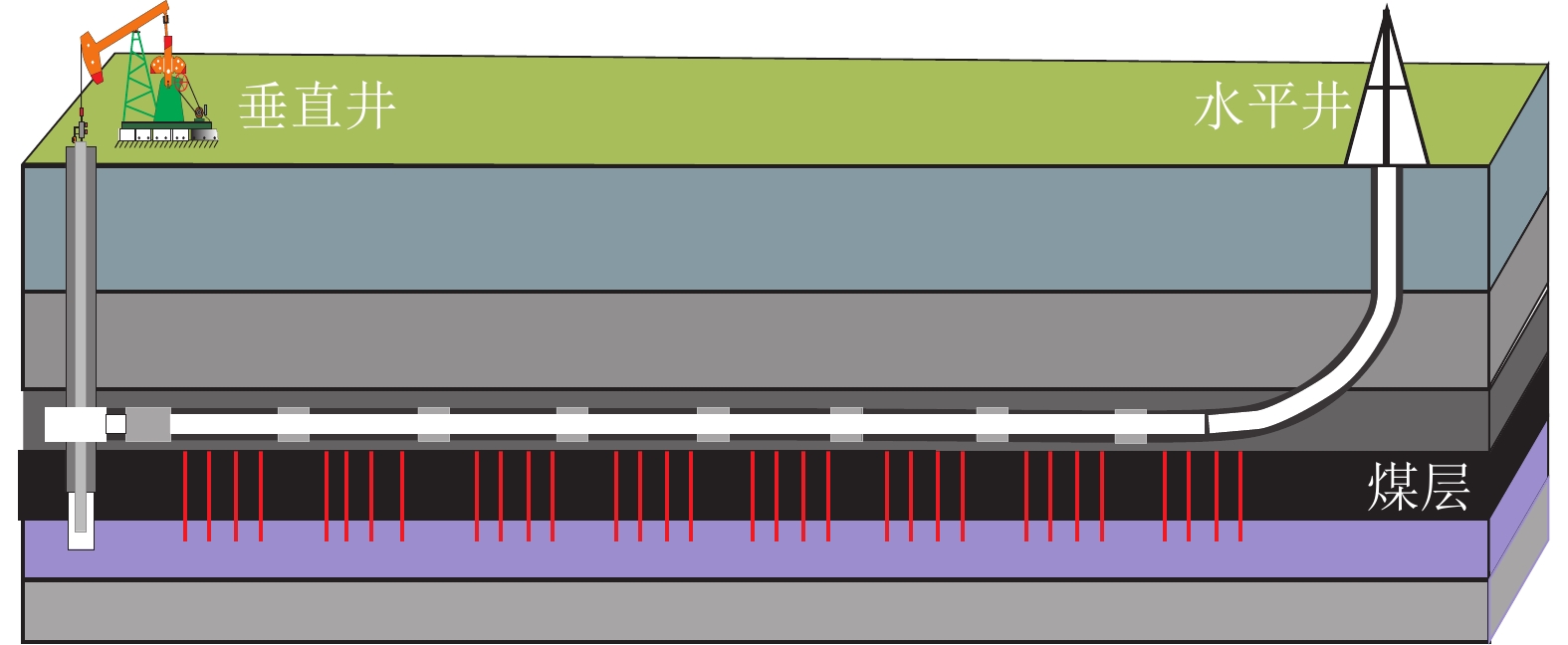
 下载:
下载:


